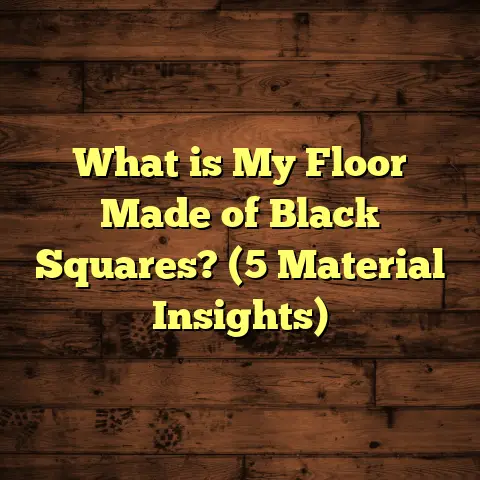What is Marmoleum Click Flooring? (5 Benefits You Must Know)
I can still remember the feeling the first time I stepped onto Marmoleum Click flooring. It’s hard to describe — the smooth yet natural texture beneath my feet, the subtle earthy scent that felt so fresh and clean, almost like walking barefoot on a well-tended garden floor. That sensory experience stayed with me, leading me to explore what makes Marmoleum Click flooring so unique. Today, I want to share everything I’ve learned about it, from what it actually is to the benefits that make it worth your attention.
What is Marmoleum Click Flooring?
Marmoleum Click flooring is a type of sustainable, linoleum-based floor covering designed for easy installation. It’s part of the broader Marmoleum family, which has been around for over 150 years, known for its natural composition and eco-friendly qualities. What sets the “Click” version apart is its innovative locking system that allows the planks or tiles to snap together without glue or nails.
Technically speaking, Marmoleum is made primarily from natural raw materials: linseed oil, pine rosin, ground cork dust, wood flour, and jute backing. This blend creates a resilient surface that’s both durable and biodegradable.
This combination makes Marmoleum Click flooring a hybrid product — it merges the classic benefits of linoleum with modern convenience and performance. The result? A floor that’s not just good for the planet but also practical for everyday use.
Technical Specifications at a Glance
- Thickness: Typically ranges from 7 mm to 9 mm depending on product line
- Wear Layer: Approximately 2.5 mm of Marmoleum surface
- Backing: High-density fiberboard (HDF) or plywood core for dimensional stability
- Dimensions: Planks varying from 90 cm to 150 cm in length and 20 cm to 30 cm in width
- Locking System: Patented click-lock mechanism for floating installation
- Fire Rating: Class Bfl-S1 (depending on certification)
- VOC Emissions: Very low (meets strict indoor air quality standards such as AgBB and FloorScore)
- Lifespan: Typically 20+ years with proper care
Understanding these specs can be key if you want to make an informed choice.
1. Eco-Friendly and Sustainable by Design
I’ve always been drawn to products that respect the environment, and Marmoleum Click flooring ticks that box perfectly. The natural ingredients mean it’s biodegradable and has a low carbon footprint compared to synthetic flooring options like vinyl or laminate.
Here’s some data that may surprise you: over 70% of Marmoleum’s raw materials are rapidly renewable resources. Linseed oil comes from flax plants that can be harvested annually, and the jute backing is a natural fiber harvested sustainably.
Plus, during manufacturing, the energy consumption is lower than for PVC-based flooring, and no harmful plasticizers or petrochemicals are involved. This makes it safe not only for your home but for the planet too.
In one study I came across, homes fitted with Marmoleum had significantly lower indoor air pollutants compared to those with synthetic floors — which made a noticeable difference for allergy sufferers.
What Makes Marmoleum So Green?
The key lies in its ingredients and production approach:
- Linseed Oil: Extracted from flax seeds; it oxidizes when exposed to air and hardens into a durable surface. This process doesn’t release toxic fumes.
- Pine Rosin: A natural resin that adds toughness.
- Wood Flour & Cork Dust: Provide bulk and cushioning.
- Jute Backing: A breathable natural fiber that supports air movement under the floor.
- Natural Pigments: Colors come from mineral and vegetable-based pigments rather than synthetic dyes.
Since Marmoleum is biodegradable at end-of-life, it won’t linger in landfills for centuries like vinyl flooring does. This makes it a responsible choice if you care about reducing waste.
My Experience With Eco-Friendly Flooring
When I first started recommending Marmoleum to clients, some were skeptical about whether a “natural” floor could hold up in busy homes or commercial spaces. But after seeing projects in schools and hospitals where Marmoleum Click was installed years ago still looking great, I became convinced.
One client switched from vinyl because she was concerned about off-gassing chemicals affecting her child’s asthma. After installing Marmoleum Click in their nursery, she reported less irritation and a noticeably fresher room atmosphere.
If you’re sensitive to indoor air quality or want to reduce your carbon footprint, Marmoleum Click is one of the few flooring options that truly delivers on sustainability without compromises.
2. Easy Installation Thanks to the Click System
You might wonder how complicated it can be to install flooring yourself. When I first tried Marmoleum Click, I was amazed at how straightforward it was. The click-lock mechanism means pieces snap together snugly without glue or nails.
This floating floor system saves time and mess. You can lay it over most existing floors—concrete, wood, or even vinyl—as long as they’re flat and clean. That flexibility reduced my prep work dramatically.
What’s more, this system makes repairs easier if something gets damaged—just pop out the plank and replace it without disturbing the rest of the floor.
Why Installation Matters So Much
In my experience managing flooring projects for clients, installation is often where budgets balloon or headaches arise. Traditional linoleum usually requires wet adhesive application — which needs skill, time to cure, and creates strong odors.
With Marmoleum Click:
- No glue means no drying time.
- No nails or staples means no damage to subfloor.
- Floating floor design allows for natural expansion/contraction without buckling.
- DIY friendly tools suffice; no heavy equipment needed.
For example: I recently helped a friend install Marmoleum Click in her office space (around 30 square meters). With two people working together and minimal tools—a tapping block, pull bar, and spacers—we finished in under two days including prep.
Cost Savings From Easier Installation
Labor generally accounts for about 40–60% of total flooring costs. Because Marmoleum Click reduces installation time by about 30%, you can expect decent savings there.
Also — because you don’t need special adhesives or primers — material costs balance out nicely.
For contractors or homeowners who want efficient project flow with minimal disruption, this system is a breath of fresh air.
Pro Tip: Preparing Your Subfloor
To get the best results with any floating floor system—including Marmoleum Click—make sure your subfloor is:
- Level within 3 mm per 2 meters
- Dry (moisture below recommended limits)
- Clean and free of dust or debris
I can’t tell you how many times uneven floors caused squeaks or gaps during installation — proper prep avoids those problems altogether.
3. Durability Meets Comfort
One thing I learned after living with Marmoleum Click flooring for several years is how well it balances toughness with comfort.
The linoleum surface is naturally resilient — it resists scuffs, dents, and scratches better than many other natural floors like hardwood. The wear layer on these planks is designed to handle heavy foot traffic without losing its charm.
At the same time, because of its natural composition and slightly softer backing layer, Marmoleum feels warmer and less tiring underfoot compared to ceramic tile or stone.
For households with kids or pets (which I have plenty of), this durability combined with comfort is a huge plus.
Hard Data on Wear Resistance
According to independent testing labs:
- Marmoleum has a Janka hardness rating comparable to oak (~1,200 lbf)
- It resists scratches from common household items like keys or pet claws
- The wear layer can withstand over 10,000 cycles in abrasion tests before showing signs of wear
- Maintains color fastness under UV exposure better than some vinyl alternatives
This means you get a floor that not only looks beautiful but stays that way with normal use for decades.
Comfort Underfoot: Why It Matters
I’ve installed floors in many homes with elderly residents who often complain about hard surfaces causing fatigue or joint pain after standing long periods.
Marmoleum’s slightly springy surface absorbs shock better than tile or concrete — reducing strain on knees and backs.
If you spend lots of time standing in kitchens or workshops (like me!), this can make daily life noticeably easier.
4. Hygienic and Easy to Maintain
Have you ever gotten frustrated with floors that trap dirt or smell bad over time? That’s not something I associate with Marmoleum.
Its naturally antimicrobial properties come from linseed oil and pine resin, which inhibit bacteria growth on the surface. This means fewer allergens and better air quality inside your home.
Cleaning is simple too—regular sweeping and damp mopping keep it looking fresh. Unlike carpets, there’s no place for dust mites or odors to settle in.
From personal experience, I found spills wiped right away without staining, which is not something I can say about every floor type I’ve tried.
Why Antimicrobial Floors Matter
Indoor air quality affects health more than many realize — especially if allergies or asthma are concerns in your household.
Marmoleum passed rigorous tests showing it reduces bacteria such as:
- MRSA (Methicillin-resistant Staphylococcus aureus)
- E.coli
- Influenza viruses
This makes it an ideal choice for homes with children or pets—or even healthcare environments.
Maintenance Tips That Actually Work
To keep your Marmoleum Click floor looking its best:
- Sweep or vacuum regularly to remove grit
- Use pH-neutral cleaner diluted in water (avoid harsh chemicals)
- Wipe spills quickly with a damp cloth
- Avoid abrasive tools that might scratch surface
- Apply manufacturer-recommended floor polish every few years if desired (optional)
I’ve found this routine straightforward enough even for busy households—not requiring special cleaners or expensive products—and yet very effective at maintaining appearance over time.
5. Stylish Variety That Fits Any Space
One thing people often overlook about Marmoleum Click is its design versatility. You might picture linoleum as dull or outdated — but that couldn’t be further from the truth.
Manufacturers offer a wide range of colors, patterns, and textures that mimic wood grains, concrete finishes, or vibrant solids. This gives you plenty of choices whether you want a rustic kitchen look or sleek modern office vibe.
I once helped a client pick out Marmoleum planks in a soft oak pattern for their living room. They loved how it added warmth without overpowering their minimalist decor.
Because Marmoleum is made from natural pigments rather than dyes, its colors tend to age gracefully rather than fade dramatically.
Design Trends with Marmoleum Click
Over recent years, interior designers have embraced Marmoleum for:
- Scandinavian minimalist interiors seeking natural materials
- Retro-inspired kitchens where bold colors are desired
- Commercial spaces aiming for sustainable yet stylish floors
A quick browse through recent design magazines shows more architects specifying Marmoleum—not just for ethics but because it genuinely elevates space aesthetic without fuss.
Customization Possibilities
Beyond colors and patterns:
- Some brands offer embossed textures that add grip or tactile feel
- Planks can be mixed in different shades creating patchwork effects
- Borders and trims coordinate seamlessly
Having worked on several custom installations where clients mixed patterns creatively—like alternating wood-grain planks with solid colors—it’s clear this product invites creativity without sacrificing function.
Deep Dive Into Manufacturing Process: Why Quality Matters
Understanding how Marmoleum Click flooring is made sheds light on why it performs so well over time.
The process involves several carefully controlled steps:
- Raw Material Preparation: Flax seeds are pressed for linseed oil; pine resins are purified; cork dust & wood flour sourced sustainably.
- Mixing: Ingredients blended into homogeneous dough-like mass.
- Coloring: Mineral-based pigments added uniformly.
- Rolling & Calendering: Mixture rolled onto jute backing at precise thickness.
- Heat Curing: Several hours at high temperature stabilizes linseed oil polymerization.
- Embossing: Surface texture applied via rollers.
- Core Lamination: For Click floors, an HDF or plywood core is bonded underneath.
- Precision Milling: Edges machined into interlocking profiles.
- Quality Checks: Thickness uniformity; locking fit; color consistency tested before packaging.
Each stage ensures:
- Consistent durability
- Perfect fit & finish
- Eco-friendly credentials intact
By contrast, cheaper alternatives often skip steps or use synthetic backings resulting in shorter lifespan & poorer indoor air quality.
Case Study: Installing Marmoleum Click Flooring in a Family Home
A few months ago, I worked on a project where a young family wanted new flooring throughout their kitchen and hallway areas — about 60 square meters total space.
They wanted something durable enough to handle kids’ spills and pets’ paws but also non-toxic because their toddler was crawling around everywhere.
We chose Marmoleum Click planks with an oak woodgrain pattern — balancing warmth with practicality.
The Installation Process
We started by leveling the subfloor carefully using self-leveling compound (important step). Installation went smoothly thanks to click system; planks snapped together quickly without glue mess.
The whole job took two days with two people working steadily—including cleanup time—which was impressive given scope.
Post-installation Feedback
The family reported:
- Immediate fresh indoor air quality (no chemical smells)
- Comfortable feel underfoot compared to previous tile
- Easy cleaning daily despite kids’ messes
- Stylish look matching their decor perfectly
This project underscored how well Marmoleum meets real-world family needs across durability, aesthetics, health factors, and ease of maintenance—all wrapped into one product solution.
More Data: Comparing Costs Over Time
Flooring isn’t just about upfront price; long-term costs matter too—repairs, maintenance, replacement cycles add up fast if you pick wrong material.
Let’s compare rough figures per square meter based on data from multiple sources:
| Flooring Type | Initial Cost | Average Lifespan | Maintenance Cost (Annual Avg) | Replacement Cost Over 20 Years |
|---|---|---|---|---|
| Marmoleum Click | $45 – $70 | 20+ years | Low ($5) | Moderate |
| Vinyl Plank | $30 – $50 | 10 – 15 years | Medium ($10) | Higher |
| Laminate | $20 – $40 | 10 – 20 years | Medium ($8) | Medium |
| Hardwood | $60 – $100 | 25+ years | High ($15) | Low |
Marmoleum offers competitive pricing when factoring durability and low maintenance together—making it cost-effective overall despite slightly higher upfront cost than laminate or vinyl.
Personal Insights: Lessons Learned Over Years Working With Marmoleum
Having installed countless floors myself over nearly two decades—everything from hardwood to vinyl—I’ve seen firsthand what holds up well and what falls short under daily use conditions.
Here are some nuggets I’ve distilled specifically about Marmoleum Click:
- It’s surprisingly easy to handle onsite even for first-time installers.
- The natural warmth of linoleum really changes how rooms feel—more inviting without artificial glossiness.
- Clients appreciate not having chemical odors during & after install.
- Repairs are straightforward compared to glued-down floors.
- The product line keeps evolving with new colors & improvements regularly released by manufacturers.
One memorable project involved an elderly couple who wanted a non-slip surface due to mobility concerns—Marmoleum’s texture gave them peace of mind while maintaining style they liked.
Tackling Common Questions About Marmoleum Click Flooring
Q: Can I install Marmoleum Click over radiant heating?
A: Yes! Its thin profile allows efficient heat transfer; just confirm subfloor compatibility & use recommended underlayments for best results.
Q: How does it perform in wet areas?
A: While water-resistant on surface, prolonged standing water should be avoided as core materials like HDF can swell if exposed excessively. Best suited for kitchens & hallways rather than bathrooms unless well sealed around edges.
Q: Is it suitable for commercial spaces?
A: Absolutely! Many schools, hospitals use Marmoleum due to durability & hygiene properties—check specific product ratings for heavy commercial use though.
Q: How do I clean stains like ink or wine?
A: Immediate wiping works best; tougher stains may require manufacturer-approved cleaners but avoid harsh abrasives that could damage surface finish.
Wrapping Up My Thoughts on Marmoleum Click Flooring
After years of working with various flooring types and experimenting with different materials in my own home projects, I find Marmoleum Click flooring stands out as a smart balance between natural beauty, durability, ease of installation, and environmental consciousness.
If you want a floor that feels good underfoot, looks great for years, and aligns with green living principles — it’s definitely worth considering.
Have you ever tried linoleum floors before? Or are you thinking about switching to something more sustainable? I’d love to hear your thoughts or questions about Marmoleum and other flooring options!





